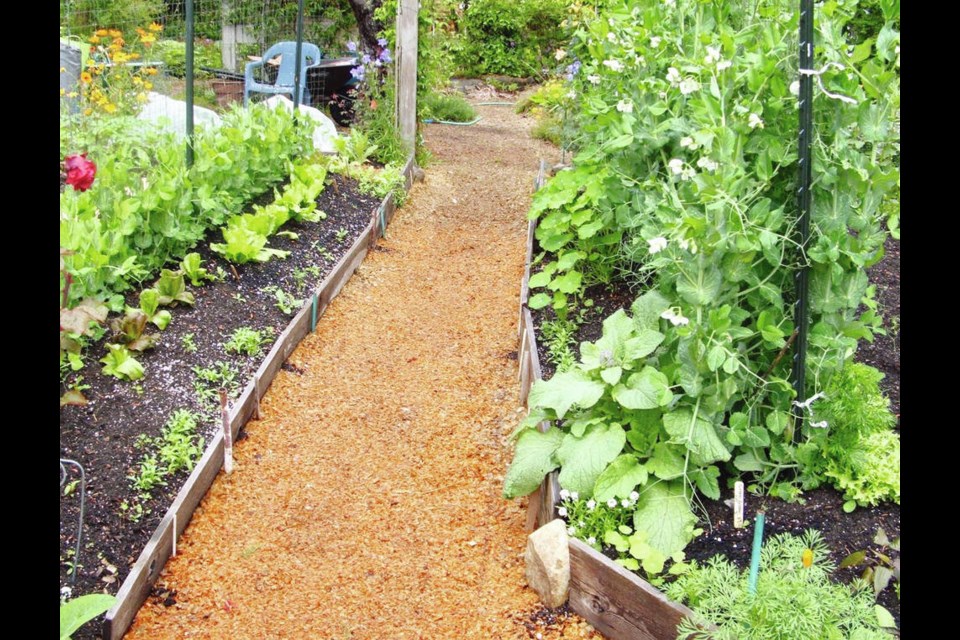After being chased out of the garden repeatedly by rain through the first half of the month, I’m relieved, as a gardener, to see summer settling in. The cool, rainy weather did get cool season vegetables off to a wonderful start though.
As always, it’s been both satisfying and frustrating to see vegetable plots and flower beds fill with new plantings — satisfying to survey the fresh growth, frustrating at the challenge of keeping up with the planting, weeding, tidying and trimming. Ample rainfall has prompted wild growth in some of the larger shrubs.
In the food garden, it’s my habit to start out early in the spring with one of the pea plantings, this year on March 29, with a second seeding made two or three weeks later, to stagger the harvesting periods.
I usually plant the peas in parallel rows, on four-metre lengths of wire. This year I decided to arrange the plantings separately, along each side of the main path through the vegetable plots, leaving room for some flowers (nasturtium, alyssum) and lettuce and endive transplants along the edge.
At the corner of one of the pea plots is a fragrant, red Don Juan climbing rose, trained on a post as a “pillar” rose. At the two other ends of the pea plots, summer-flowering Clematis viticella vines grow up and over a little arbour at the entrance to the vegetable garden, each clematis growing accompanied by a climbing miniature rose.
Among miniature climbing roses, Laura Ford is considered a classic. The small, double blooms are a deep yellow. They are sweetly fragrant, and take on tinges of apricot-pink as they age.
At the base of both rose-clematis pairings, blue bellflowers have appeared and formed small clumps, thanks to their self-sowing habit.
I acquired the seeds and planted peach-leaved bellflower (Campanula persicifolia) years ago. Ever since, the plants have made welcome appearances to produce summer flowers in various spots throughout the garden. — welcome because the plants take up little room yet give a lovely display of large, bell-shaped, blue or white flowers. The slender, 60 to 90 cm stems bear narrow leaves.
Tomatoes and Canada Day. Heather Derby, who gardens in Saltair, has come up with a patriotic method of caring for her tomato plants:
“I wanted to share with you my tomato covers. I purchased these head umbrellas from our local dollar store and adapted them to fit over tomato cages. I was tired of large umbrellas blowing off in the wind. These seem to keep rain off the plants and hopefully I’ll have a good crop of ripe fruits this year. If nothing else, the project is my contribution to Canada Day.”
The photo Heather sent along with her note shows caged tomato plants capped with small red and white umbrellas. A sign in the garden reads “Gardening — Cheaper than therapy, and you get tomatoes.”
Greenhouse tomato issues. Another gardener, who lives in an exposed, cool and windy part of the Victoria area, wrote to say that his tomato plants need the protection of a greenhouse in order to ripen fruit.
He wondered why the fruit set was so poor on his healthy plants, until he found out that, in the still air of the greenhouse, the plants lacked the air movement (and insect activity) needed to transfer pollen from the male to the female part of each flower. In a greenhouse, either a fan (or fans) to circulate the air, or a gentle shaking of the plants, will facilitate the transfer.
A manual agitation of the flowering plants is best done late in the morning, when overnight dampness will have been dispelled and the pollen will have dried enough to accomplish its purpose of fertilizing the flowers.
Another pollination issue that has arisen in the hot summers of recent years is temperatures that rise high enough in greenhouses to sterilize tomato pollen. Temperatures above 30 C can render pollen sterile, and useless for the pollination process. A fan, or fans, can help here too, for circulating and cooling the air as well as facilitating the movement of pollen.
Slither revisited. In response to my describing encounters with snakes in the garden, and my chronic aversion to them, Bob emailed from Nanoose Bay. He thought I’d want to know that “the proper name for the fear of snakes that you have is reptile dysfunction.”



